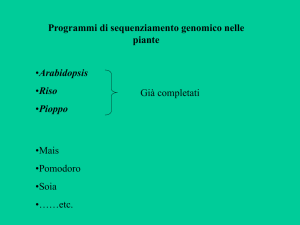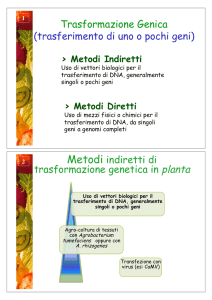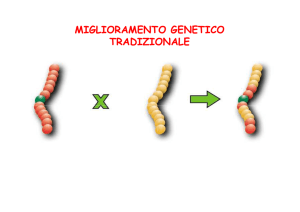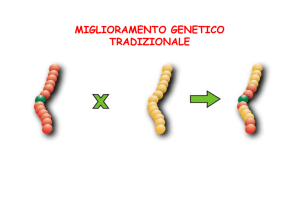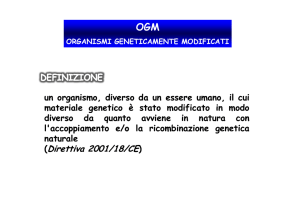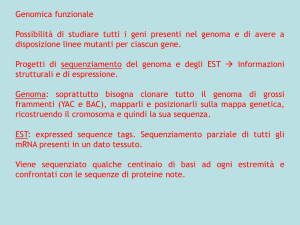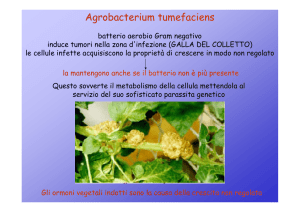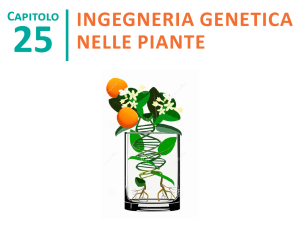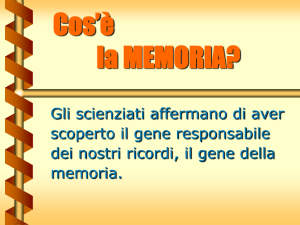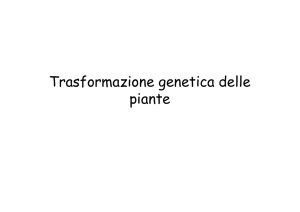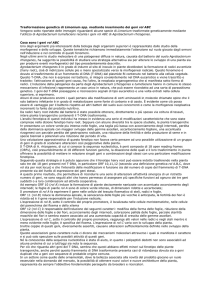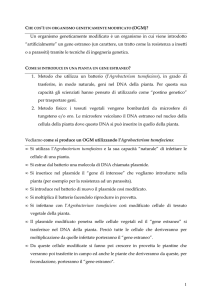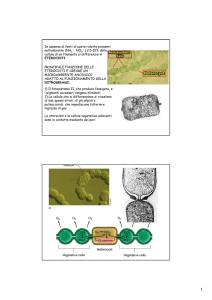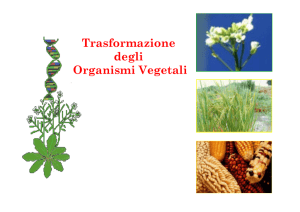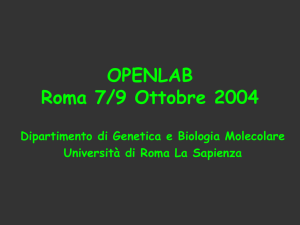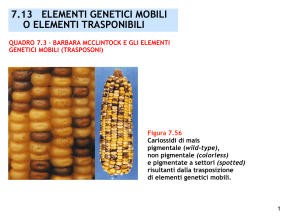Andrea Allavena - ordine dottori agronomi e forestali la spezia
annuncio pubblicitario
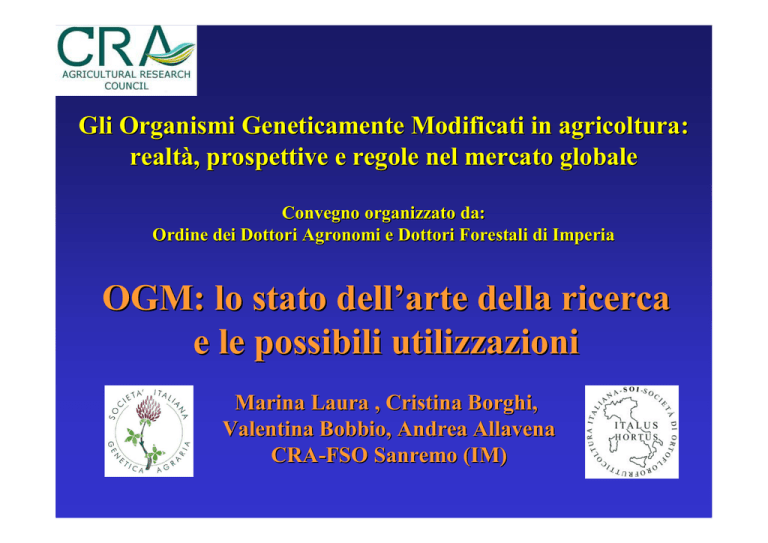
Gli Organismi Geneticamente Modificati in agricoltura: realtà, prospettive e regole nel mercato globale Convegno organizzato da: Ordine dei Dottori Agronomi e Dottori Forestali di Imperia OGM: lo stato dell’arte della ricerca e le possibili utilizzazioni Marina Laura , Cristina Borghi, Valentina Bobbio, Andrea Allavena CRA-FSO Sanremo (IM) Lavori pionieristici di trasformazione Trasformazione mediata da Agrobacterium Identificazione del plasmide Ti di Agrobacterium (Engler et al., 1975 Dimostrazione della capacità di Agrobacterium di trasformare le cellule vegetali (Schell e Van Montagu, 1977) Ottenute le prime piante di tabacco transgeniche da due diversi gruppi (Mary-Dell Chilton e Jeff Schell ) utilizzando il plasmide Ti come vettore (Barton et al 1983; Herrera-Estrella et al., 1983) Trasformazione diretta Elettroporazione (Fromm et al., 1985) Microproiettili (Klein et al., 1987 Transformation Methods Method Agrobacterium Biolistics (method) for corn for wheat Silicon carbide fibers Microinjection Equipment/ Supply Strains Helium gun Fibers Microscope & injector Pollen transformation by Electroporator electroporation for corn Electroporation Electroporator Electrophoresis Potential License Required Japan Tobacco (grasses) Monsanto (canola, cotton, soybean) 4-way interference: Novartis, Monsanto, Max-Planck, U. of Leiden DuPont DeKalb/Pioneer Novartis Zeneca Calgene BTG MARS sequences DeKalb Various depending on species (Boyce Thompson) Mycogen Apparatus ? Microinjection http://farm2.staticflickr.com/1300/47200700 97_4082e801b6_z.jpg Biolistic / Gene Gun PSD-1000/He Particle Delivery System http://arabidopsis.info/students/anna/biolisti cs.gif Specie di Agrobacterium rilevanti per la trasformazione delle piante • A. tumefaciens • A. rhizogenes • A. rubi • A. vitis Plasmide generico di A. tumefaciens (tipo octopina) http://www.patentlens.net/daisy/AgroTran/1 053/version/default/part/ImageData/data Peter Sforza, Geanie McMeans, Fabricio Medina-Bolivar, Dan Tillman, George Lacy, Mary Ann Hansen, and John Jelesko Sequenze dei bordi del T-DNA Bordo Sequenza LB-TL (oct) ggcGGCAGGATATATtcaatTGTAAAc RB TL (oct) acTGGCAGGATATATaccgtTGTAATt LB-TR (oct) ggTGGCAGGATATATcgaggTGTAAAa RB TR (oct) gaTGGCAGGATATATcgaggTGTAATt TL (nop) ggTGGCAGGATATATtgtggTGTAAAc TR (nop) ttTGGCAGGATATATtggcggGTAAAc LB-TL (Ri) ggTGGCAGGATATATtgtgaTGTAAAc RB-TL (Ri) acTGaCAGGATATATgttccTGTcATg LB pGreen ctTGGCAGGATATATtgtggTGTAAAg RB pGreen ctTGaCAGGATATATtggcggGTAAAc Consensus xxTGGCAGGATATATxxxxxTGTAAA/T P-DNA Rommens et al., 2005, 139:1338-1349 Rommens et al(2005)Plant Physiology 139:1338-1349 Trasformazione mediata da Agrobacterium Courtesy of [http://biologi.uio.no/plfys/haa/gen/gmo.h tm Halvor Aarnes A gall caused by Agrobacterium tumefaciens. Agrobacterium rhizogenes Catharanthus hairy roots Kirsi-Marja Oksman-Caldentey, VTT Modalità di formazione e di trasferimento del T-strand Vir Gene expression induced Phenolics detected by the VirA/VirG two component sensor system. Vir D1 & D2 cut T-DNA at right and left borders. Formation of T-complex AGROBACTERIUM T-DNA VirD2 attaches to exposed 5I end Bacterial Plasmid VirA VirG Formation of T-Pilus PLANT CELL Phenolics Produced by Wounded Plant cell VIP1 associates with the complex to target it to the nucleus T-DNA integrates into plant DNA and gall production is initiated. VIP2 associates the complex to transcriptionally active DNA Modalità di integrazione del T-DNA Proposti numerosi modelli (elica singola o doppia?) L’integrazione è favorita da zone ricche di AT (microomologie) con cui si appaia il LB Vir D2 legata al 5’ del T-DNA stimola l’attività della DNA ligasi 1 e si lega anche ad altre proteine (Es.: DRT112) L’integrazione comporterebbe una delezione del DNA genomico Nel caso classico di integrazione, al 5’ del T-DNA sono tagliate 3 basi del border Al 3’ il numero di basi tagliatedel border può variare A model of the T-DNA integration process. The given example is for a putative T-DNA that, as a consequence of its integration is deleted by six nucleotides in the 3' LB [position (b) in Figure 2A] but complete in its RB. For convenience, only the upper strand of the host DNA is represented. A T-rich region [T(n)] operates as a preferential site of entry of the T-DNA LB. Starting from its 3' end, the T-DNA scans the plant DNA until it finds a microcomplementarity just downstream of the T-rich region. A nick (2) is generated in the host DNA downstream of the microcomplementarity-based duplex and used as a priming site to synthesize the complementary strand of the T-DNA until the 5' RB covalently linked to VirD2 is reached. The integration process of the newly synthesized double-stranded DNA frequently brings about a deletion in the host DNA. Recombination between the host bottom strand and the T-DNA operates at sites 1 and 3 after the action of exonucleases on both ends of the T-DNA. Brunaud et al., EMBO reports, 3:1152-1157 Modifiche apportate ai plasmidi utilizzati per la trasformazione genetica delle piante Plasmide generico di A. tumefaciens (tipo octopina) TC TR Catabolismo opine Geni di virulenza TL ~250 kb Ori V TL Auxine citochinine si lic a p e R TR Sintesi octopine Plasmide generico di A. tumefaciens (tipo nopalina) Catabolismo opine Geni di virulence T-DNA ~190 kb Ori V si lic a p e R T-DNA Auxine citochinine Sintesi opine Ceppi di A. tumefaciens Ach5 .......... agrocinopine, octopine type B6S3, A6 .... octopine type Bo542 ......... leucinopine, succinamopine, agropine type, vir weaker than A281 C58, T37 .... nopaline types A281 .......... succinamopine, leucinopine, agrocinopine Genotypes of some useful A. tumefaciens strains LBA4404 (Ach5 pTiAch5) Sm/Sp(R) in the virulence plasmid (from Tn904); all T-DNA of pTiAch5 eliminated in pAL4404 (Hoekema et al., 1983). EHA101, genotype C58 pTiBo542; T-region::aph, Km(R); A281 derivative harboring pEHA101, T-DNA replaced with nptII, elimination of T-DNA boundaries uncofirmed, super-virulent (Hood et al., 1986). EHA105 is a Km(S) derivative of EHA101 (Hood et al., 1993). AGL1, genotype is AGL0 (C58 pTiBo542) recA::bla, T-region deleted Mop(+) Cb(R) [AGL0 is an EHA101 with the T-region deleted, which also deletes the aph gene] (Lazo et al., 1991). A281, reconstructed strain, derivative of A136 (cured C58) harboring pTiBo542, super-virulent (Hood et al., 1986). Evoluzione dei vettori di trasformazione di A. tumefaciens Vettori cointegrati Vettori binari Altri COSTRUZIONE DI pGV3850 MEDIANTE RICOMBINAZIONE OMOLOGA Amp R pAcgB Catabolismo opine Ori V Nop Geni di virulence T-DNA pGV3839 si lic a p e R T-DNA Auxine citochinine Sintesi opine Plasmide cointegrato Nop pGV3850 Ori V si lic a p e R Catabolismo opine Geni di virulenza Amp R Vettore binario Altri vettori Plant Molecular Biology 42: 819–832, 2000. © 2000 Kluwer Academic Publishers. Printed in the Netherlands. 819 pGreen: a versatile and flexible binary Ti vector for Agrobacterium-mediated plant transformation Roger P. Hellens, E. Anne Edwards, Nicola R. Leyland, Samantha Bean and Philip M. Mullineaux John Innes Centre, Norwich Research Park, Colney, Norwich, NR4 7UH, UK (author for correspondence; e-mail: [email protected]; fax: C44 1603 456844) Sistema PGreen/pSoup pGreen con T-DNA minimo (2534 bp) CGTTAACAAAGCTTGGGACCGCGGTGGAATTCCAGCTATGAAGG AATTGTTTCGAACCCTGGCGCCACCTTAAGGTCGATACTTCC Hind III Hpa I Eco RI LB RB TTAGAGATCTTGGCAGGATATATTGTGGTGTAAA CCTTGACAGGATATATTGGCGGGTAAACTAA AATCTCTAGAACCGTCCTATATAACACCACATTTGC GGAACTGTCCTATATAACCGCCCATTTGATT Bgl II Acl I Stu I Strumenti per l’analisi del numero di copie del transgene e dei siti di integrazione • Segregazione • Southern blot •Quantitative PCR • Sequenziamento delle giunzioni • Ibridazione in situ (FISH) Sequenziamento delle giunzioni mediante AL-PCR Passi fondamentali: •Digestione •Ligazione •Amplificazioni nested •Sequenziamento Prodotti di amplificazione mediante AL-PCR CLONE 441RB 1kb CLONE 426 LB 1 B 1kb 1 2 3 4 5 A 2036bp 2036 bp 1636bp 1636bp 1018bp 1018 bp Le bande ottenute sono sequenziate direttamente o previo clonaggio in vettore Prodotti di amplificazione ottenuti mediante AL-PCR LIBRERIE CLONI TRANS GENICI ScaI RsaI LB RB LB RB Clone 426 2800bp 2000bp 180bp 300bp 2000bp 900bp 700bp 1600bp Clone 428 400bp Non verificato 6500bp 3100bp 2500bp Clone 441 Non verificato Non verificato 1800bp 700bp 3200bp 2900bp 2300bp 1600bp Caso tipico d’integrazione 1 61 121 181 241 301 361 421 481 541 601 NTTTNAGTTGCCCNCNTTTTGGCTGTCAAGATGCGAAAGCACGTGAGAGACAAGTAAATC ACGAAAGCATTTTTCGGGAGATGTGGAGACTTTATTACCATACAATCATAGCGAAGATAG GCATCAAGGAATCGTTTGGAATTCCACCGCGGTCCCAAGCTTTGTTAACGTTACACCACA ATATATCCAGAGCTATCCTTTGGAGCACGTTGAACTCCTAAGATGTTATCTAGACATAAG GTAGAATTTTGGAATTTCTCCAACTTCCTATTTAAGTCTACAGTTTTCACTTTAACGTCT GCTAGCTCCTTATTTTTATCAGCTAGTTGTTGAGTTAAGTCTTGAATGTGTTCATACAGC ATGTCAATATTATTTGCTCATTTTCCAGATCTTTTAGTGCAGTTCTATCCTTAGCATCTG ACTTAAGTTTATCAGTTAAATCATTCTTTATATCTTTTAAGCTGACATTCTCAAGTTTTA AGTTATCATTTTCAACACGCATAGGTTCACTATTCTCAACTAGCATCTTAATCCTATTAG ACATATCAATATGAGACCTGCAAATATTAGTAACAACAGATAAATCTAAACGTACCTGCC CAGGCCGTCNACCACGCNNGGGCCCCTATAGTANNGNNNNNNNGNCNGNNGGNNANGGNG Rol ABC Adattatore Left Border CL 441 RsaI 700bp LB Genoma Delezione del tratto terminale del T-DNA 1 61 121 181 241 301 361 421 481 541 601 661 721 NNNNNNNNNNNNNTGNCTGTCAGANGCGAAAGCACGTGAGAGACAAGTAAATCACGAAAG CATTTTTCGGGAGATGTGGAACATGTTCAGGAGACGGTTCAGGAGCTGATTCAGAAGGCG GTCCGGGAGTCGGTTCAGGAGCCAGTTCGGGAGTTGTGGTTGGAACAGGTTGTTCTTCAA TAGCAAATGGATCAAGATGTATGAGATATGACTTTGTCATATGATGAGCACTAGCAGGAA AATGGAAAAGAATGGAATGTGTTCCAAAAACATAACATGCCGTGATACATATAGTTTTTG ATGGTTTTCTCTGGCGATTCACCTCAGGACTTCAAGGGGACGTTGTAGGTTGCTTTTGGT GGTGTTTAGAACGTAAAATATGTTTCAAAATTTGTGTTTTCGATTGGTTAGGGTTTTGCG ATGGTGTGGTGGTCGTGGGTGGATTCCGGTGGTGGCAGGAGGTGGTTGTGATGGTGTTGA TCGTCTGGAGAAGGTGATGGTGATGGTGATGTCGGCTGTAGTGCAGAGGAAGGAGAGGGA GAGGTGTAAACTGAGGCTAGGGTTTCAAGATTAAGTTTATATATGTCTAGGGTTTTCTCA AAGGATGGTAATCGGACCAGGCTTGGCTAAGTCCAGCTAGTGGTAGGTCAAGAGTGGTCC TGGACTGACCTTGGGTCGTATGGCTCGATGGTGATGGCCCAGGCAATCCTCGTGTGTTGG TTTTATGTACCTNNNCGGNNNNNNNNNNACGCGTGCCCTATANTNNNNN Cl 426 RsaI 900bp LB 1 TTTTAGTTGCCCCNTTTTGGCTGTCAAGATGCGAAAGCACGTGAGAGACAAACCTGCCCG 61 GGCCGTCGACCACGCGTGCCCTATAGTANNNNNNNNNNN Rol ABC Genoma Cl 426 ScaI 200bp LB Mancato riconoscimento del border 1 61 121 181 241 301 361 421 481 541 CAGTTGCCCNNNTTTTGGCTGTCAAGATGCGAAAGCACGTGAGAGACAAGTAAATCACGA AAGCATTTTTCGGGAGATGTGGAGACTTTATTACCATACAATCATAGCGAAGATAGGCAT CAAGGAATCGTTTGGAATTCCACCGCGGTCCCAAGCTTTGTTAACGTTACACCACAATAT ATCCTGCCAAGATCTAATTCCGGGGATCGGAAATCCAGAAGCCCGAGAGGTTGCCGCCTT TCGGGCTTTTTCTTTTTCAAAAAAAAAATTTNNAAAANNANNTGGTGGGGCCGGCCCCCG GGTTGGGGGCAAAGGGNCCCNAAGGGGGGNAACCNNTTGGGGTTGGCCNCGGGGGGAACC GGGGGNNNTAACNNATTGGCCNNAANCCNAGGGGGANCAAAAANNGNAAAAAAAATTCNA AANTGNAAANNNAANTGNAAAAANCANTTGGGGGAANNANTTGNCGGAANGAGGGGGGGT TGNAAACTGNTGANCNGAAAGGGNNNNTAANGNTCCCCCGGGNCNTTTTGNNTAANGANT TCCCGGGNCC Rol ABC adattatore plasmide border genoma Cl 426 RsaI 700bp LB Filler sequ. Riarrangiamento del T-DNA 1 61 121 181 241 CGCGCAATANAATGAAAATTGCCAAAATTAGCTATCGGTCTTCTGAAAAGAAGGGCCGAC ATGTTTTCATAGACCATGCAAAGTCATACTACCTGAAACTGATAAATAACGACAAAGAAA TTTCCACGCCGGAGATGATATCGAATATGTTCTGTTAAGTTAAAATAAGCTGCGAGCCAT GGCGCGATTGTCCTGTTTTATTAATATAGTACCTGCCCGGGCCGTCGACCACGCGGTGGC NCTATANNANNA Rol ABC Rol ABC Genoma Cl 426 RsaI 700bp RB Ibridazione in situ (FISH) Eliminazione dei marcatori Metodi disponibili per ottenere piante marker-free • Cotrasformazione e segregazione • Ricombinazione sito specifica: - sistema cre/loxP - sistema attP Costituzione di genotipi T1 attraverso co-trasformazione con 2 ceppi di Agrobacterium tumefaciens di cui uno porta il gene marcatore selezionabile (gene NPTII) e l’altro il gene utile (gene 35SGUS) Identificazione di genotipi primari T1 che esprimono entrambi i geni Autofecondazione Analisi delle progenie T2 Analisi espressione dei 2 geni Espressione gene NPTII Rigenerazione su terreno selettivo Espressione gene 35SGUS Saggio istochimico Risultati espressione delle progenie Genotipi T1 C2 D4 8 N2 B4 N1 N1 Progenie T2 Espressione (N° di piante per classe) GUS+ GUS+ GUSGUSKmR KmS KmR KmS 129 0 42 0 113 0 5 29 207 0 4 63 316 0 104 1 59 23 25 8 138 5 6 1 120 5 24 1 Segregazione Genotipi T1 Progenie T2 Ipotesi di segregazione (test X2) + −) C2 D4 8 N2 B4 N1 N1 GUS ( / 3:1 3:1 3:1 3:1 3:1 15:1 3:1 Km (R/S) >63:1 3:1 3:1 >63:1 3:1 15:1 15:1 Site-specific recombination-mediated excision of marker genes eg. CRE/Lox consisting of: •CRE recombinase •34bp lox recombination sites; substrate for the recombinase Removal of superfluous genes from a transgenic plant using inducible CRE/lox inducer LB gene to be retained unwanted gene RB inducible CRE recombinase LB RB Phil Mullineaux John Innes Centre, Colney, Norwich (phil. [email protected]) NR4 7UH, UK lox site Ricombinazione intracromosomica: attP Sequenze di ricombinazione di 352 pb (regione di attacco del batteriofago λ nelle regioni attB del DNA di E. coli La ricombinazione è ricombinasi indipendente Site specific recombination: the attP system Useful gene attP Useful gene attP tms2 Marker gene attP Alternatives to antibiotic resistance markers Example : Use of Phosphomannose Isomerase (PMI) Mannose Mannose-6-phosphate PMI Fructose-6-phosphate Selection on mannose as sole C source and against mannose-6phosphate accumulation Rol C e rol ABC conferiscono vantaggio selettivo rol C gene (Spena et al.1987) pGreen II 0000 plasmid (www.pgreen.ac.uk Osteospermum ecklonis L. Tecniche di ingegnerizzazione di precisione: Zink finger nucleases Mutagenesi sito specifica mediante taglio con Zink Finger Nucleases e successiva riparazione dei frammenti via ricombinazione non omologa Opportunità per mutare geni di specifico interesse The Plant Journal Volume 57, Issue 4, pages 747-757, 24 NOV 2008 DOI: 10.1111/j.1365-313X.2008.03718.x http://onlinelibrary.wiley.com/doi/10.1111/j.1365-313X.2008.03718.x/full#f7 MemoGene™ Technology: bypass current barriers to breeding. Alexander Vainstain MemoGene™ Technology: a unique patented technology for precise plant genomic modifications toward new and better traits in crops. L’ingegneria genetica nelle specie ornamentali La trasformazione genetica integra e non sostituisce le tecniche classiche di miglioramento genetico Modificazioni del colore dei fiori Tecnica di modificazione Colore del fiore Antisenso Senso Originale Transgenico Chs Rosa Arancio Bianco Bianco Chs Chs Rosa Rosa Bianco Bianco Chs Dfr Rosso Rosso Rosa/Crema Rosa Bianco Lilla Rosso Rosa Specie Garofano Fht Crisantemo Gerbera Petunia Ben-Meir et al., 2002 Lc F3’h Durata dei fiori post-raccolta Controllo biosintesi dell’etilene Methionine S-adenosyl methionine (ACS) 1-Aminocyclopropane-1-carboxylic acid (ACC) (ACD) (ACO) Ethylene Durata dei fiori post-raccolta Recettori dell’etilene ETR1: Recettore di segnale dell’etilene. - Il gene mutante etr-1 induce insensibilità all’etilene - Possibilità di utilizzare promotori tessuto specifici Senescenza delle piante in vaso - Durante l’allevamento in serra in condizioni di elevato investimento - Durante il trasporto - In appartamento Senescenza delle piante in vaso Interventi - geni del fitocromo - geni del criptocromo - sintesi e recettori etilene - geni ormonali Controllo della ricerca della luce Esempi di trasformazione di specie ornamentali con Agrobacterium Trasformazione con i geni rol TL- DNA di A. rhizogenes Osteospermum ecklonis: controllo e pianta transgenica T1 (35SrolC) Ornamental traits modification by Rol genes in Osteospermum ecklonis transformed with Agrobacterium tumefaciens Authors: Giovannini, Annalisa; Zottini, Michela; Morreale, Giacomo; Spena, Angelo; Allavena, Andrea Source: In Vitro Cellular and Development Biology - Plant, Volume 35, Number 1, January 1999 , pp. 70-75(6) Osteospermum ecklonis: campo incroci (T1 x varietà e dettaglio di progenie selezionata) Trasformazione con il gene N di TSWV GENETIC TRANSFORMATION AND HYBRIDIZATION Evaluation of resistance in Osteospermum ecklonis (DC.) Norl. plants transgenic for the N protein gene of tomato spotted wilt virus A.M. Vaira, T. Berio, G. P. Accotto, M. Vecchiati and A. Allavena Plant Cell Reports Volume 19, Number 10, 983-988, DOI: 10.1007/s002990000226 Introduzione di resistenze a TSWV mediante trasformazione con il gene N (nucleoproteina virale) Resistenza al freezing in Osteospermum indotta da espressione di Osmyb4. Piante trattate per una notte a -5°C senza (A) o con acclimatazione per 10 giorni a 4°C (B) Metabolic response to cold and freezing of Osteospermum ecklonis overexpressing Osmyb4 Marina L., R. Consonni, F. Locatelli, E. Fumagalli, A. Allavena, I. Coraggio, M. Mattana Plant Physiology and Biochemistry Volume 48, Issue 9, September 2010, Pages 764– 771 Studio dell’espressione genica EPIPHILLY (VEGETATIVE VIVIPARY) in Kalanchoe x houghtonii peculiar type of asexual reproduction, leads to the formation of novel complete plantlets on mature organs (leaves, stems, roots, flower stalks) process is widespread to several families (Liliaceae, Graminaceae, Crassulaceae) may be switched on by environmental stimuli (short vegetative seasons, low light intensity, stresses) The plantlets are formed on leaf margin notches in response to a long day photoperiod and their appearance follow a basipetal fashion. Sequenziati 6 geni KNOX di cui 2 di classe 1 omologhi di STM e BP di Arabidopsis Sovraespressione e silenziamento di KxhKN5 Over-expression and silencing cassette coding sequence promoter terminator 35S NOS KxhKN5 XhoI XbaI NotI NotI NotI/BamHI FseI/XbaI promoter Intron terminator PIV2 35S 35S PstI PstI BamHI NotI XbaI XbaI KxhKN5 fragment KxhKN5 fragment 5’’ 326 bp KxhKN5 antisense fragment 3’ 5’’ 3’ 326 bp KxhKN5 sense fragment Modifica della forma delle foglie Expression of KxhKN4 and KxhKN5 genes in Kalanchoë blossfeldiana 'Molly' results in novel compact plant phenotypes: towards a cisgenesis alternative to growth retardants. Lütken H, Laura M, Borghi C, Ørgaard M, Allavena A, Rasmussen SK. Plant Cell Rep. 2011 Dec;30(12):2267-79. Epub 2011 Aug 18. Food Percent Modified in US Percent Modified in world Soybeans 93% 77% Corn, field (Maize) 86% 26% Cotton (cottonseed oil) 93% 49% Hawaiian papaya 80% Tomatoes Taken off the market due Small quantities grown in to commercial failure. China Canola Sugar cane Sugar beet Rice Squash (Zucchini) Sweet Peppers 93% 95% (2010); planting in 2011 under controlled conditions Forecast to be on the market in 2013[23] 13% 21% 9% Small quantities grown in China •^ a b Acreage NASS National Agricultural Statistics Board annual report, June 30, 2010. Retrieved July 23, 2010. •^ a b USA:Cultivation of GM Plants in 2009, Maize, soybean, cotton: 88 percent genetically modified GMO Compass. Retrieved July 25, 2010. •^ a b Field areas 2009, Genetically modified plants: Global cultivation on 134 million hectares GMO Compass. Retrieved July 25, 2010. •^ Ronald, Pamela and McWilliams, James Genetically Engineered Distortions The New York Times, May 14, 2010, Mentions that today 80% of Hawaiian papaya is genetically engineered. Retrieved July 26, 2010. •^ Wright, Brierley How Healthy Is Canola Oil Really? "Eating Well", March/April 2010 edition, Mentions 93% of rapeseed in the US is GM. Retrieved July 26, 2010. •^ Johnson, Stanley R. et al Quantification of the Impacts on US Agriculture of Biotechnology-Derived Crops Planted in 2006 National Center for Food and Agricultural Policy, Washington DC, February 2008. Retrieved August 12, 2010. L. Semeria A. Giovannini T. Berio M. Laura G. Morreale Ringraziamenti C. Regis G. Safaverdi E. Filidei C. Borghi I. Rambaldi CNR –IVV Torino CNR-IBBA Milano University of Copenhagen Grazie per l’attenzione
